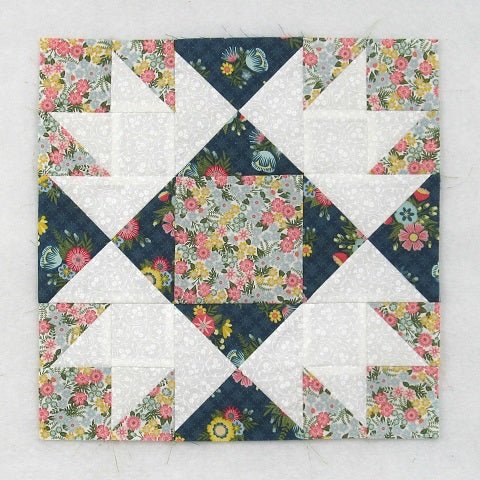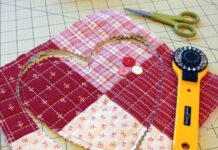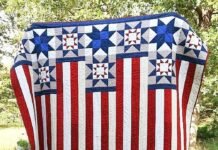The Union Square Quilt Block is a classic and versatile design that has stood the test of time.
Its intricate geometric patterns and balanced symmetry make it a favorite among quilters, whether they’re beginners or seasoned experts.
This block combines both tradition and creativity, offering countless opportunities for customization.

The Union Square Quilt Block is perfect for various projects, from cozy quilts to decorative pillows and table runners. Its adaptable nature allows quilters to experiment with different color schemes and fabric choices, giving each project a unique flair. In this article, we will explore the history, design process, and creative applications of the Union Square Quilt Block while providing practical tips to bring your vision to life.
Let’s dive into the world of quilting and uncover how this timeless pattern can transform your next project into a masterpiece.
1. History and Origins of the Union Square Quilt Block
The Union Square Quilt Block has a rich history rooted in American quilting traditions. Its design reflects the creativity and resourcefulness of early quilters who crafted beautiful patterns from simple materials.
- Historical Context: This quilt block emerged in the 19th century, a period when quilting was both a necessity and an art form. It symbolizes unity and strength, resonating with themes of community and collaboration.
- Regional Variations: The pattern has been interpreted differently across regions, with subtle variations in layout and color choices.
- Symbolic Meaning: The square’s symmetrical design often represents balance, harmony, and interconnectedness, making it a meaningful addition to any quilt.
- Popularity Over Time: The Union Square Quilt Block has remained a staple in quilting due to its versatility and aesthetic appeal.
- Revival in Modern Quilting: Contemporary quilters have embraced this classic design, incorporating modern fabrics and bold color palettes.
- Inspiration from History: Understanding the block’s origins can inspire quilters to add their unique touch while preserving its traditional essence.
2. How to Create the Union Square Quilt Block
Creating a Union Square Quilt Block involves careful planning and precise execution. Here’s a step-by-step guide to help you get started.
- Step 1: Gather Materials: Collect your fabric, thread, rotary cutter, ruler, and sewing machine. Choose fabrics that contrast well to highlight the block’s geometric design.
- Step 2: Measure and Cut Fabric: Accurately cut squares and triangles according to your desired block size. Precision is key to achieving clean lines and a polished finish.
- Step 3: Assemble the Pieces: Lay out the fabric pieces to visualize the final design. This helps ensure proper placement before sewing.
- Step 4: Sew the Units Together: Start by sewing smaller units, like half-square triangles, before assembling the entire block. Use a consistent seam allowance for uniformity.
- Step 5: Press the Seams: Press each seam flat to reduce bulk and ensure a neat appearance.
- Step 6: Join the Sections: Combine the units to form the complete block. Double-check alignment to maintain the pattern’s symmetry.
Tips for Success
- Use a design wall to preview your layout.
- Invest in quality tools for precise cutting and stitching.
- Practice on scrap fabric to build confidence with the pattern.
- Label pieces to avoid confusion during assembly.
- Take your time to ensure accuracy at every step.
3. Creative Applications of the Union Square Quilt Block
The Union Square Quilt Block is incredibly versatile, lending itself to various creative projects. Here are some ideas to inspire your next quilting endeavor.
- Traditional Quilts: Use the block in a repeating pattern for a classic quilt design.
- Modern Quilts: Experiment with oversized blocks and bold colors for a contemporary twist.
- Pillows and Cushions: Create stylish throw pillows by incorporating a single Union Square block.
- Table Runners and Placemats: Add elegance to your dining table with quilted accessories featuring this pattern.
- Wall Hangings: Showcase the block as a standalone piece of art by framing it.
- Patchwork Clothing: Integrate the design into wearable items like jackets or tote bags.
Enhancing Your Projects
- Combine the Union Square block with other patterns for a dynamic quilt.
- Use seasonal fabrics for holiday-themed decor.
- Incorporate embroidery or applique for added texture and detail.
- Play with scale by creating mini or jumbo versions of the block.
- Share your creations online to connect with the quilting community.
4. Troubleshooting and Improving Your Skills
Even experienced quilters face challenges when working with intricate patterns like the Union Square Quilt Block. Here are some common issues and solutions.
- Misaligned Seams: Double-check measurements and seam allowances to prevent mismatched sections.
- Frayed Edges: Use sharp cutting tools and handle fabric carefully to minimize fraying.
- Uneven Blocks: Press seams thoroughly and trim excess fabric to maintain uniformity.
- Fabric Selection Issues: Choose high-quality, colorfast fabrics to avoid bleeding or fading.
- Time Management: Break the project into smaller steps to avoid feeling overwhelmed.
- Skill Development: Practice different techniques, such as half-square triangles, to build confidence and expertise.
Building Confidence
- Start with smaller projects to master the basics.
- Join quilting workshops or online tutorials for guidance.
- Seek feedback from fellow quilters to refine your skills.
- Document your progress to track improvement over time.
- Celebrate small achievements to stay motivated.
FAQ about the Union Square Quilt Block
Q1: What size is a typical Union Square Quilt Block?
A: The size can vary, but common dimensions range from 6 to 12 inches square.
Q2: Can beginners attempt this pattern?
A: Yes, with patience and attention to detail, beginners can successfully create this block.
Q3: What fabrics work best for this block?
A: Cotton fabrics are ideal due to their durability and ease of handling.
Q4: How many blocks are needed for a full quilt?
A: The number depends on your quilt’s size. A standard throw-size quilt may require 20-30 blocks.
Q5: Can I hand-sew the Union Square Quilt Block?
A: Absolutely! While machine sewing is faster, hand-sewing adds a personal touch.
Q6: How do I ensure my blocks are consistent in size?
A: Use a consistent seam allowance and trim blocks to the correct dimensions after assembly.
Conclusion
The Union Square Quilt Block is a timeless design that offers endless possibilities for creative expression. By understanding its history, mastering the assembly process, and exploring innovative applications, you can create stunning pieces that celebrate tradition and individuality. Whether you’re crafting a quilt, a table runner, or a decorative pillow, this pattern is sure to impress.
We’d love to hear about your experiences with the Union Square Quilt Block. Share your thoughts, suggestions, and photos in the comments below to inspire fellow quilters. Happy quilting!





